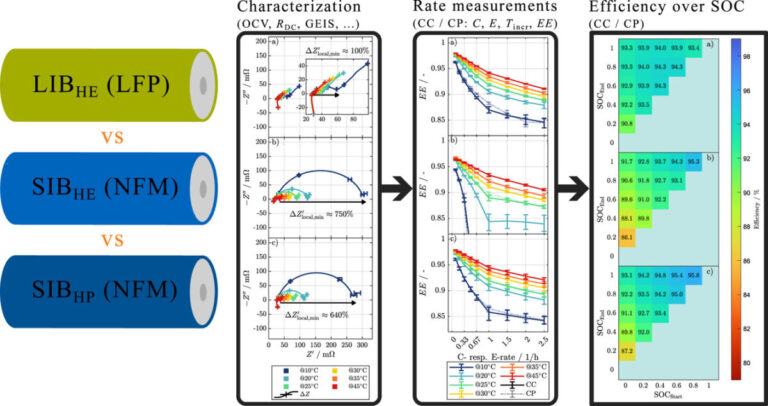Researchers in Germany have compared the electrical behavior of sodium ion batteries with that of lithium-iron phosphate batteries under different temperatures and state-of-loading. Their work shows how the advanced significantly influences the efficiency of Sodiumion devices while cycling.
Researchers from the Technical University of Munich (TUM) and RWTH Aachen University in Germany have compared the electrical performance of energy batteries with high energy (SIBs) with those of a state-of-the-art high-energy lithium-ion battery (libs ) With a lithium-iron phosphate (LFP) cathode and have discovered that the state-of-caring and temperature have a higher influence on the pulse resistance and the impedance of the SIBs than the libs.
“SIBs are generally seen as a drop-in replacement for libs,” the scientists said. “Nevertheless, the differences in the electrochemical behavior of sodium and lithium adjustments require both the anode and the cathode. While graphite is usually used as anodem material for LIBs, hard carbon is currently seen as the most promising material for SIBs. “
They also explained that their work was meant to fill in a gap in the study, because there is still a lack of knowledge about the electrical behavior of SIBs in terms of different temperatures and state-of-loads (SOCs) .
The research team in particular carried out electrical performance measurements at temperatures ranging from 10 ° C to 45 ° C and open circuit voltage measurements of the entire cell at different temperatures and half -cell measurements of the corresponding cells at 25 C.
“We also investigated the influence of temperature and soc on both resistance of the direct current (R dc) and galvanostatic electroclocy impedance spectroscopy (geis), “it specified. “To investigate the usable capacity, usable energy and energy efficiency under dynamic conditions, we have performed speed tests by applying different loading speeds at different temperatures.”
The measurements were taken on a lib, a SIB based on a nickel-Manganese-iron cathode and a lib with an LFP cathode, in which all devices showed a hysteresis in the open circuit voltage between charging and discharging.
“Interesting is that for SIBs the hysteresis mainly occurs with low socs, which according to half cell measurements is probably due to the hard carbon anode,” the academics emphasized. “The R DC And impedance of the lib shows very little dependence on the soc. For SIBs, on the other hand, the R dc and impedance are increasing considerably in socs below 30%, while higher socs have the opposite effect and lead to lower R DC and impedance values. “
Moreover, they have established that the temperature dependence of R DC and impedance are higher for SIBs than Libs. “The LIB tests do not show a significant influence of the SOC on the Round trip efficiency. Cycling of the SIBs from 50% to 100% SOC can reduce the efficiency losses by more than half compared to bicycles from 0% to 50%, ”they explained further, and noted that the efficiency of SIBs is growing drastically when cycling of the cells in a higher SOC range compared to a lower SOC range.
Their findings are available in the study “Comparison of the electrical performance of commercial sodiumion and lithium-iron phosphate batteriesPublished in the Journal of Power Sources. “Our findings indicate that the admission statement during cycling significantly influences the efficiency of sodium ion batteries and must therefore be taken into account,” they concluded.
This content is protected by copyright and may not be reused. If you want to work with us and reuse part of our content, please contact: editors@pv-magazine.com.


